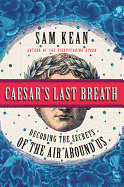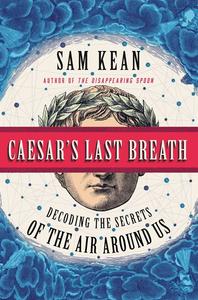
 Journalist and frequent NPR guest Sam Kean has made a living out of deciphering science and making clever and entertaining what is often dry drudgery. In The Disappearing Spoon, for example, he unravels the Periodic Table of Elements by traveling through the often outrageous, sometimes courageous lives of the scientists and adventurers who discovered, isolated and named them. The Tale of the Dueling Neurosurgeons is an anecdotal history of neuroscience and brain research. In Caesar's Last Breath, he takes on the science of gases in his trademark effervescent, loopy style--kicking it off with the emergence of Earth from a fiery, uninhabitable atmosphere, a "dragon's breath of volcanoes."
Journalist and frequent NPR guest Sam Kean has made a living out of deciphering science and making clever and entertaining what is often dry drudgery. In The Disappearing Spoon, for example, he unravels the Periodic Table of Elements by traveling through the often outrageous, sometimes courageous lives of the scientists and adventurers who discovered, isolated and named them. The Tale of the Dueling Neurosurgeons is an anecdotal history of neuroscience and brain research. In Caesar's Last Breath, he takes on the science of gases in his trademark effervescent, loopy style--kicking it off with the emergence of Earth from a fiery, uninhabitable atmosphere, a "dragon's breath of volcanoes."
From the planet's hellish beginnings, Kean works his way through the evolution of the atmospheric building blocks of life: oxygen and nitrogen. Biology, chemistry and geology turn quickly into comedic stories, wordplay and metaphors. The search to molecularly combine nitrogen with hydrogen to make ammonia ("the gateway to fertilizer") leads him to the eccentric 20th-century German scientist Fritz Haber and his engineer countryman Carl Bosch. The two succeeded at producing commercial quantities of ammonia and supplied the world with its agricultural bounty, but they also became the fathers of German chemical warfare in World War I and developed synthetic gasoline to fuel Hitler's war engine.
Oxygen, too, has a rich story. Its discovery has been credited to "a preacher and rabble-rouser named Joseph Priestley," but equal kudos arguably should go to the French aristocrat chemist Antoine-Laurent Lavoisier. Scientific rivals to corral oxygen, both contributed to the science of gases, and both came to unpleasant ends: Priestley escaped England for the United States when his radical theology led to the burning of his church and home in the 1791 Birmingham Priestley Riot, and Lavoisier was beheaded on the Jacobin's guillotine during the French Revolution.
In a similar vein, Kean highlights the other key elements of Earth's atmosphere and the unusual and downright freaky stories behind their discovery. In the process, he wanders through a delightful series of asides and interludes that include the Mount St. Helens eruption, World War I gas warfare, refrigeration, vacuum technology, greenhouse gases, even the significance in the big planetary atmospheric picture of humans and animals "passing gas." If he occasionally gets a bit corny in his search for colloquial humor (e.g. "Mount Saint Helens was actually small beer as far as eruptions go"), Kean can also put a metaphor right on the money--such as his description of the birth of the Earth's volatile moon as "glowing like a blackened, bloodshot eye. There still might have been poetry in this moon, but it was more Dante than Frost." Irreverent, lightly scientific, Caesar's Last Breath is nonetheless a lively, rewarding journey through the evolution of Earth's gaseous atmosphere. As Kean concludes noting the eternal ubiquity of Caesar's last breath: "Dust to dust, gases to gases." --Bruce Jacobs, founding partner, Watermark Books & Cafe, Wichita, Kan.
Shelf Talker: Sam Kean takes on the science and evolution of Earth's atmosphere and the history of the scientists who unraveled its mysteries.

